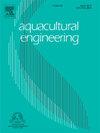Using a passive solar greenhouse with water tanks in overwintering of juvenile sea cucumber Apostichopus japonicus
IF 4.3
2区 农林科学
Q2 AGRICULTURAL ENGINEERING
引用次数: 0
Abstract
The present work investigated the overwintering of juvenile sea cucumber Apostichopus japonicus which used a renewable energy system. The experimental period ranged from December 2023 to February 2024. Seawater, benefited from a temperature rise of about 3 °C in an underground pond, was pumped into 3.6 m3 plastic tanks on a rooftop greenhouse of a single-story building and heated by solar radiation. There were 56 such tanks in the greenhouse - half of them (28) were placed close to the south-oriented plastic film and the other half near the north-oriented wall. Those 28 tanks were subdivided into 4 groups of 7 tanks. Each group was heated for 4 days before the content was drained into the sea cucumber culture tanks of 10 m3 placed on ground floor of the building. For those 4 days of winter the water in the tanks was heated to an average of 15–20 °C in the south and 10–15 °C in the north. The culture tanks were divided into two groups to correspond to the south and north tanks and throughout the winter the average water temperatures were maintained at 16 ± 3 °C and 12 ± 3 °C respectively. The numerical experiments confirmed that if the greenhouse is developed into a double-plastic film greenhouse, the temperature of the tanks can be raised to 20.8 °C in the south and 16.4 °C in the north for 4 days even in the lowest atmospheric temperature. The three-month experiment witnessed the increase of average body weight of juvenile sea cucumber from 0.7 to 4.2 g along with its survival rate of 94.8 % and specific growth rate of 1.87 %d−1. This indicates that the passive solar greenhouse has a great potentiality to reduce energy demand of animal houses using electricity or coal in winter.
带水箱的被动式日光温室在刺参幼参越冬中的应用
本文研究了利用可再生能源系统越冬刺参幼参的过程。实验期为2023年12月至2024年2月。由于地下池塘温度上升约3°C,海水被泵入单层建筑屋顶温室的3.6 m3塑料水箱中,并通过太阳辐射加热。温室里有56个这样的水箱,其中一半(28个)靠近朝南的塑料薄膜,另一半靠近朝北的墙壁。28辆坦克被分成4组,每组7辆。每组加热4天,然后将内容物排入位于建筑物底层的10 m3海参培养池中。在冬季的那4天里,水箱里的水被加热到南方平均15-20°C,北方平均10-15°C。将培养池分为南池和北池两组,整个冬季平均水温分别保持在16±3°C和12±3°C。数值试验证实,若将大棚发展成双层塑料薄膜大棚,即使在最低大气温度下,也可连续4天将罐体温度南向提高到20.8℃,北向提高到16.4℃。经过3个月的试验,海参幼鱼的平均体重由0.7增加到4.2 g,成活率为94.8 %,特定生长率为1.87 %d - 1。这表明被动式太阳能温室在减少冬季用电或燃煤畜舍的能源需求方面具有很大的潜力。
本文章由计算机程序翻译,如有差异,请以英文原文为准。
求助全文
约1分钟内获得全文
求助全文
来源期刊

Aquacultural Engineering
农林科学-农业工程
CiteScore
8.60
自引率
10.00%
发文量
63
审稿时长
>24 weeks
期刊介绍:
Aquacultural Engineering is concerned with the design and development of effective aquacultural systems for marine and freshwater facilities. The journal aims to apply the knowledge gained from basic research which potentially can be translated into commercial operations.
Problems of scale-up and application of research data involve many parameters, both physical and biological, making it difficult to anticipate the interaction between the unit processes and the cultured animals. Aquacultural Engineering aims to develop this bioengineering interface for aquaculture and welcomes contributions in the following areas:
– Engineering and design of aquaculture facilities
– Engineering-based research studies
– Construction experience and techniques
– In-service experience, commissioning, operation
– Materials selection and their uses
– Quantification of biological data and constraints
 求助内容:
求助内容: 应助结果提醒方式:
应助结果提醒方式:


